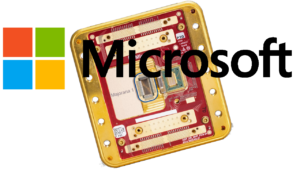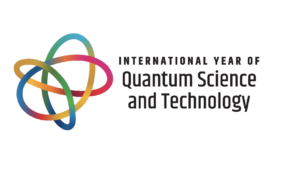At the end of a post entitled “Quantum Computing: The Quest Continues,” I indicated that I would write another article discussing some of the advances being made in the search for a less quirky qubit. The qubit is the sine qua non for quantum computing. The qubit’s ability to be both a zero and a one simultaneously is what will theoretically allow quantum computers to perform an incredible number of calculations at lightning speeds. If you want a fuller explanation of how qubits are used to accomplish this, watch the following video.
A press release from the University of California, Santa Barbara, notes, “A fully functional quantum computer is one of the holy grails of physics. Unlike conventional computers, the quantum version uses qubits (quantum bits), which make direct use of the multiple states of quantum phenomena. When realized, a quantum computer will be millions of times more powerful at certain computations than today’s supercomputers.” [“Superconducting qubit array points the way to quantum computers,” Science Codex, 23 April 2014] The focus of the article is research being conducted by a team of UC Santa Barbara physicists that demonstrated “a new level of reliability in a five-qubit array.” Their findings were published in the journal Nature.
Qubits are notoriously unstable and fragile. Historically, the best way to stabilize them has been to create them at extremely cold temperatures (near absolute zero) and surround them with shielding. The UCSB team (headed by John Martinis, a professor in UCSB’s Department of Physics) also uses this technique. “The unique configuration of the group’s array results from the flexibility of geometry at the superconductive level, which allowed the scientists to create cross-shaped qubits they named Xmons. Superconductivity results when certain materials are cooled to a critical level that removes electrical resistance and eliminates magnetic fields. The team chose to place five Xmons in a single row, with each qubit talking to its nearest neighbor, a simple but effective arrangement.” The team discovered that this simple, two-dimensional arrangement provided the most stability and fewest errors. “Motivated by theoretical work, we started really thinking seriously about what we had to do to move forward,” said Professor Martinis. “It took us a while to figure out how simple it was, and simple, in the end, was really the best.”
As you can imagine, cooling any object, even atomic particles, to near absolute zero is challenging and expensive. That’s why research being conducted at Simon Fraser University in British Columbia is so intriguing. According to an article in the Latino Post, researchers there “have been able to preserve a qubit at room temperature for a 39 minutes. Previous attempts have lasted only seconds. The extended length of preservation means that it is theoretically possible to build such qubits into solid-state hardware, making them more commercially feasible.” [“Researchers Make Breakthrough in Qubit Viability,” 16 November 2013] Team member, Stephanie Simmons, who also co-authored an article published in Science, notes that this breakthrough is “not going to be something you can use tomorrow. It’s just a step on the way.”
Another intriguing research project on qubits currently underway is being conducted at Bell Labs by Bob Willett, who is attempting to create a “topological qubit.” [“Forging a Qubit to Rule Them All,” by Natalie Wolchover, Quanta Magazine, 15 May 2014] What, you may ask, is a topological qubit and how does it differ from a “normal” qubit? Wolchover reports, “Scientists have already built qubits, but if Willett’s topological version — which would store information in the braided paths of particles — is realized, it has the potential to be much more stable than existing prototypes. Experts say it could become the most promising foundation on which to build a full-scale quantum computer.” As noted in the video, the more qubits you can create for use in a quantum computer the greater the computer power it will possess. As Wolchover writes, “The key to building a quantum computer is increasing the number of qubits that can be linked together.” She continues:
“Despite the investment of vast resources over the past 20 years, the extreme fragility of existing qubits has so far restricted efforts to network them and has even fueled uncertainty about whether the technology will ever materialize. Topological qubits, however, would offer a fundamental advantage: Although they would rely on a rare and extraordinarily finicky quantum state (one so difficult to conjure that at present, only Willett can consistently do it), once formed, they theoretically would behave like sturdy knots — resistant to the disturbances that wreck the delicate properties of every other kind of qubit.”
John Preskill, a professor of theoretical physics and director of the Institute for Quantum Information and Matter at the California Institute of Technology, told Wolchover, “From a theorist’s perspective, topological quantum computing is the most elegant way of achieving robust quantum computation. But the people who were interested in doing topological stuff got kind of frustrated and decided it would be awfully hard — except for Willett.” I suspect that even Willett finds it “awfully hard” to create topological qubits. The difference is that Willett apparently has the willpower and drive to do it. According to Wolchover, “Willett works seven days a week, even on holidays, in the bleak labyrinth of Bell Labs, pursuing his goal with an uncommonly single-minded devotion.” One might assume from Wolchover’s statement that “only Willett can consistently” create topological qubits that others have managed to create them; but, that apparently is not the case. Wolchover reports that evidence is still coming in. She writes:
“Over the past few years, [Willett] has gathered a growing body of evidence that ultra-pure, ultra-cold, ultra-magnetized gallium arsenide crystals give rise to the strange particles, called ‘non-abelian anyons,’ that are required for a topological qubit. The quality of Willett’s data, and support from theory and numerical calculations, leads many outside experts to believe the effects he is seeing are real. And yet, Willett’s experiment is so difficult that no other labs have managed to replicate it, leaving open the possibility that his striking observations of non-abelian anyons are mere artifacts of his particular setup or technique. Nonetheless, Willett has decided to press on, and recently started construction on what could be the world’s first topological qubit.”
The scientific world doesn’t need another “cold fusion” episode in which only a single lab can create suspect results. Unlike the cold fusion claims, however, Willett’s work is attracting believers. “I think there’s a high chance of success,” states Chetan Nayak, a theoretical physicist at Microsoft Research Station Q and the University of California, Santa Barbara. who collaborates with Willett. “We’ve thought of as many things as we could think of and don’t see anything that’s a deal-breaker.” If you want to learn more about “non-abelian anyons,” I suggest you read Wolchover’s entire article, which also contains a lot of other interesting information. She concludes, “If non-abelian anyons exist and can be braided, they can theoretically form the building blocks of a robust, scalable quantum computer.”




